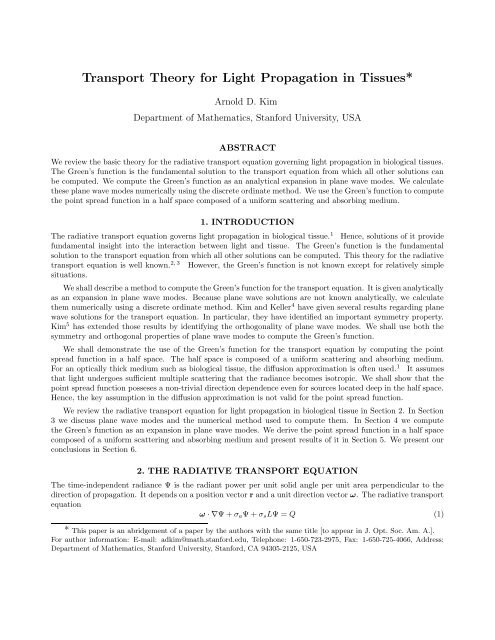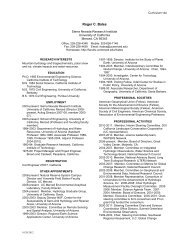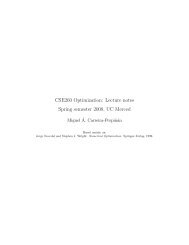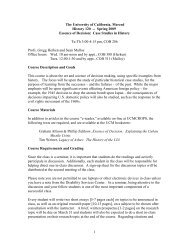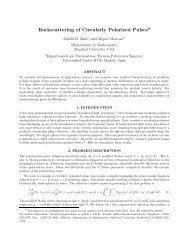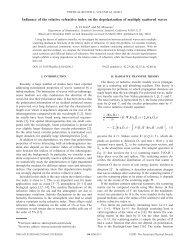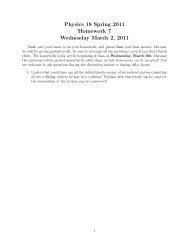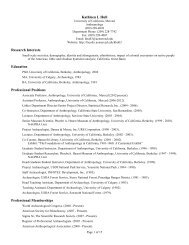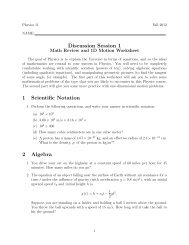Transport Theory for Light Propagation in Tissues*
Transport Theory for Light Propagation in Tissues*
Transport Theory for Light Propagation in Tissues*
Create successful ePaper yourself
Turn your PDF publications into a flip-book with our unique Google optimized e-Paper software.
<strong>Transport</strong> <strong>Theory</strong> <strong>for</strong> <strong>Light</strong> <strong>Propagation</strong> <strong>in</strong> <strong>Tissues*</strong><br />
Arnold D. Kim<br />
Department of Mathematics, Stan<strong>for</strong>d University, USA<br />
ABSTRACT<br />
We review the basic theory <strong>for</strong> the radiative transport equation govern<strong>in</strong>g light propagation <strong>in</strong> biological tissues.<br />
The Green’s function is the fundamental solution to the transport equation from which all other solutions can<br />
be computed. We compute the Green’s function as an analytical expansion <strong>in</strong> plane wave modes. We calculate<br />
these plane wave modes numerically us<strong>in</strong>g the discrete ord<strong>in</strong>ate method. We use the Green’s function to compute<br />
the po<strong>in</strong>t spread function <strong>in</strong> a half space composed of a uni<strong>for</strong>m scatter<strong>in</strong>g and absorb<strong>in</strong>g medium.<br />
1. INTRODUCTION<br />
The radiative transport equation governs light propagation <strong>in</strong> biological tissue. 1 Hence, solutions of it provide<br />
fundamental <strong>in</strong>sight <strong>in</strong>to the <strong>in</strong>teraction between light and tissue. The Green’s function is the fundamental<br />
solution to the transport equation from which all other solutions can be computed. This theory <strong>for</strong> the radiative<br />
transport equation is well known. 2, 3 However, the Green’s function is not known except <strong>for</strong> relatively simple<br />
situations.<br />
We shall describe a method to compute the Green’s function <strong>for</strong> the transport equation. It is given analytically<br />
as an expansion <strong>in</strong> plane wave modes. Because plane wave solutions are not known analytically, we calculate<br />
them numerically us<strong>in</strong>g a discrete ord<strong>in</strong>ate method. Kim and Keller 4 have given several results regard<strong>in</strong>g plane<br />
wave solutions <strong>for</strong> the transport equation. In particular, they have identified an important symmetry property.<br />
Kim 5 has extended those results by identify<strong>in</strong>g the orthogonality of plane wave modes. We shall use both the<br />
symmetry and orthogonal properties of plane wave modes to compute the Green’s function.<br />
We shall demonstrate the use of the Green’s function <strong>for</strong> the transport equation by comput<strong>in</strong>g the po<strong>in</strong>t<br />
spread function <strong>in</strong> a half space. The half space is composed of a uni<strong>for</strong>m scatter<strong>in</strong>g and absorb<strong>in</strong>g medium.<br />
For an optically thick medium such as biological tissue, the diffusion approximation is often used. 1 It assumes<br />
that light undergoes sufficient multiple scatter<strong>in</strong>g that the radiance becomes isotropic. We shall show that the<br />
po<strong>in</strong>t spread function posseses a non-trivial direction dependence even <strong>for</strong> sources located deep <strong>in</strong> the half space.<br />
Hence, the key assumption <strong>in</strong> the diffusion approximation is not valid <strong>for</strong> the po<strong>in</strong>t spread function.<br />
We review the radiative transport equation <strong>for</strong> light propagation <strong>in</strong> biological tissue <strong>in</strong> Section 2. In Section<br />
3 we discuss plane wave modes and the numerical method used to compute them. In Section 4 we compute<br />
the Green’s function as an expansion <strong>in</strong> plane wave modes. We derive the po<strong>in</strong>t spread function <strong>in</strong> a half space<br />
composed of a uni<strong>for</strong>m scatter<strong>in</strong>g and absorb<strong>in</strong>g medium and present results of it <strong>in</strong> Section 5. We present our<br />
conclusions <strong>in</strong> Section 6.<br />
2. THE RADIATIVE TRANSPORT EQUATION<br />
The time-<strong>in</strong>dependent radiance Ψ is the radiant power per unit solid angle per unit area perpendicular to the<br />
direction of propagation. It depends on a position vector r and a unit direction vector ω. The radiative transport<br />
equation<br />
ω · ∇Ψ + σaΨ + σsLΨ = Q (1)<br />
* This paper is an abridgement of a paper by the authors with the same title [to appear <strong>in</strong> J. Opt. Soc. Am. A.].<br />
For author <strong>in</strong><strong>for</strong>mation: E-mail: adkim@math.stan<strong>for</strong>d.edu, Telephone: 1-650-723-2975, Fax: 1-650-725-4066, Address:<br />
Department of Mathematics, Stan<strong>for</strong>d University, Stan<strong>for</strong>d, CA 94305-2125, USA
governs Ψ <strong>in</strong> a scatter<strong>in</strong>g and absorb<strong>in</strong>g medium. The absorption and scatter<strong>in</strong>g coefficients are denoted by σa<br />
and σs, respectively. Q denotes a source. The scatter<strong>in</strong>g operator L is def<strong>in</strong>ed as<br />
<br />
LΨ = Ψ(ω, r) −<br />
Ω<br />
f(ω · ω ′ )Ψ(ω ′ , r)dω ′ . (2)<br />
Integration <strong>in</strong> (2) takes place over the unit sphere Ω. The scatter<strong>in</strong>g phase function f gives the fraction of light<br />
scattered <strong>in</strong> direction ω due to light <strong>in</strong>cident <strong>in</strong> direction ω ′ . We assume that it depends only on the cos<strong>in</strong>e of<br />
the scatter<strong>in</strong>g angle ω · ω ′ .<br />
The solution of (1) <strong>in</strong> a spatial doma<strong>in</strong> D with boundary surface S is determ<strong>in</strong>ed uniquely by <strong>in</strong>ternal sources<br />
and the radiance <strong>in</strong>cident on the surface. 2 Hence, (1) is a well-posed problem provided that it is supplemented<br />
with boundary conditions of the <strong>for</strong>m<br />
Ψ(ω, rs) = h(ω, rs), ω ∈ Ω<strong>in</strong>(rs), rs ∈ S. (3)<br />
Ω<strong>in</strong>(rs) is the set of unit direction vectors po<strong>in</strong>t<strong>in</strong>g <strong>in</strong>to D at rs. It is def<strong>in</strong>ed as Ω<strong>in</strong>(rs) = {ω : ω · ˆn(rs) > 0}<br />
with ˆn(rs) denot<strong>in</strong>g the unit <strong>in</strong>ward normal at rs.<br />
The solution to (2) with (3) <strong>in</strong> a doma<strong>in</strong> D with boundary S is given by the general representation <strong>for</strong>mula2, 3 :<br />
<br />
Ψ(ω, r) = G(ω, r; ω ′ , r ′ )Q(ω ′ , r ′ )dω ′ dr ′ <br />
+ G(ω, r; ω ′ , r ′ s) [ω ′ · ˆn(r ′ s)] Ψ(ω ′ , r ′ s)dω ′ dr ′ s. (4)<br />
D<br />
Ω<br />
The Green’s function G(ω, r; ω ′ , r ′ ) is the solution of (1) <strong>in</strong> the whole space with Q(ω, r) = δ(ω − ω ′ )δ(r − r ′ )<br />
that is bounded <strong>for</strong> all r = r ′ . The surface <strong>in</strong>tegral term <strong>in</strong> (4) conta<strong>in</strong>s the Green’s function <strong>for</strong> a source located<br />
at the boundary surface. It is <strong>for</strong>mally def<strong>in</strong>ed as the limit<strong>in</strong>g value of the Green’s function as the source location<br />
2, 3<br />
approaches the boundary from with<strong>in</strong> the doma<strong>in</strong>.<br />
The second term <strong>in</strong> (4) requires that the radiance at the boundary surface be known <strong>for</strong> all directions.<br />
However, we know it only <strong>for</strong> directions po<strong>in</strong>t<strong>in</strong>g <strong>in</strong>to the doma<strong>in</strong> from (3). To obta<strong>in</strong> the radiance over the<br />
rema<strong>in</strong><strong>in</strong>g directions, we must solve the surface <strong>in</strong>tegral equation3 <br />
Ψ(ω, rs) = G(ω, rs; ω ′ , r ′ )Q(ω ′ , r ′ )dω ′ dr ′ <br />
+<br />
D<br />
Ω<br />
S<br />
S<br />
Ω<br />
Ω<br />
G(ω, rs; ω ′ , r ′ s) [ω ′ · ˆn(r ′ s)] Ψ(ω ′ , r ′ s)dω ′ dr ′ s. (5)<br />
This <strong>in</strong>tegral equation is <strong>for</strong> the radiance over all directions. Hence it is a coupled system of <strong>in</strong>tegral equations<br />
<strong>for</strong><br />
<br />
Ψ(ω, rs) =<br />
Ψ<strong>in</strong>(ω, rs)<br />
Ψout(ω, rs)<br />
ω ∈ Ω<strong>in</strong>(rs),<br />
ω ∈ Ωout(rs),<br />
(6)<br />
with Ωout(rs) = {ω : ω · ˆn(rs) < 0}. By solv<strong>in</strong>g (5), we determ<strong>in</strong>e Ψ on S <strong>for</strong> all directions. The solution<br />
anywhere <strong>in</strong> D follows from evaluat<strong>in</strong>g (4).<br />
3. PLANE WAVE MODES<br />
We study plane wave mode solutions to the homogeneous transport equation which is (1) with Q = 0. Plane<br />
wave solutions take the <strong>for</strong>m<br />
Ψ(ν, µ, ρ, z) = 1<br />
(2π) 2<br />
<br />
V (ν, µ; κ)e λ(κ)z+iκ·ρ dκ. (7)<br />
R 2<br />
In (7) we express the position vector as r = (ρ, z) and the direction vector as ω = (ν, µ). Substitut<strong>in</strong>g (7) <strong>in</strong>to<br />
(1) and Fourier trans<strong>for</strong>m<strong>in</strong>g that result with respect to ρ yields the eigenvalue problem<br />
λµV + iν · κV + σaV + σsLV = 0. (8)<br />
Both λ and V depend on κ parametrically. A portion of the eigenvalue spectrum is cont<strong>in</strong>uous. 2 In the<br />
discussion that follows, discrete sums are meant to <strong>in</strong>clude <strong>in</strong>tegration over the cont<strong>in</strong>uous spectrum.
3.1. Symmetry<br />
For each pair [λ(κ), V (ν, µ; κ)] solv<strong>in</strong>g (8), the pair [−λ(κ), V (ν, −µ; κ)] also solves it. 4 In light of this symmetry,<br />
we order the eigenvalues by their real part. Furthermore, we <strong>in</strong>dex the eigenvalues so that Re[λj] > 0 <strong>for</strong> j > 0<br />
and Re[λj] < 0 <strong>for</strong> j < 0. Hence, the symmetry property of plane wave modes is given as<br />
3.2. Orthogonality<br />
λ−j = −λj, V−j(ν, µ; κ) = Vj(ν, −µ; κ), j = 1, 2, . . . (9)<br />
For two different pairs [λj, Vj(ν, µ)] and [λk, Vk(ν, µ)] satisfy<strong>in</strong>g<br />
λjµVj + iν · κVj + σaVj + σsLVj = 0, (10a)<br />
λkµVk + iν · κVk + σaVk + σsLVk = 0. (10b)<br />
We multiply (10a) by Vk and (10b) by Vj, <strong>in</strong>tegrate both results over the unit sphere and take the difference.<br />
This manipulation yields<br />
<br />
(λj − λk) Vj(ν, µ)Vk(ν, µ)µdω = 0. (11)<br />
Ω<br />
From (11) we determ<strong>in</strong>e that the plane wave modes are orthogonal with respect to an <strong>in</strong>ner product hav<strong>in</strong>g<br />
weight µ.<br />
Suppose C is the value of the <strong>in</strong>tegral<br />
<br />
Ω<br />
Vj(ν, µ)Vj(ν, µ)µdω = C. (12)<br />
Chang<strong>in</strong>g µ to −µ <strong>in</strong> (12) and us<strong>in</strong>g (9), we determ<strong>in</strong>e that<br />
<br />
V−j(ν, µ)V−j(ν, µ)µdω = −C. (13)<br />
In view of (13) we normalize plane wave modes as<br />
3.3. Completeness<br />
<br />
Ω<br />
Ω<br />
Vj(ν, µ)Vj(ν, µ)µdω =<br />
<br />
+1 <strong>for</strong> j < 0,<br />
−1 <strong>for</strong> j > 0.<br />
It can be shown that plane wave modes are complete over the full range. 2 We now show that half of them are<br />
complete over the half range. Consider the one dimensional problem, homogeneous half space problem<br />
<strong>in</strong> the half space z > 0 with the boundary condition<br />
(14)<br />
µ∂zΨ(ω, z) + σaΨ(ω, z) + σsLΨ(ω, z) = 0, (15)<br />
Ψ(ω, 0) = h(ω), ω · ˆz > 0. (16)<br />
We impose also that the solution is bounded <strong>for</strong> all z > 0. The solution to this problem exists and is unique.<br />
Because of planar symmetry, we need only to consider plane wave modes <strong>for</strong> κ = (0, 0). Us<strong>in</strong>g completeness<br />
of plane wave modes, we write the general solution to (15) as<br />
Ψ(ω, z) = <br />
aje λjz Vj(ω). (17)<br />
j
To impose boundedness <strong>for</strong> all z > 0, we set aj = 0 <strong>for</strong> j > 0 to remove exponentially grow<strong>in</strong>g terms <strong>in</strong> (17).<br />
Impos<strong>in</strong>g the boundary condition (16), we obta<strong>in</strong> the l<strong>in</strong>ear system<br />
<br />
ajVj(ω) = h(ω), ω · ˆz > 0. (18)<br />
j 0}. There<strong>for</strong>e, half of the plane wave modes (those <strong>for</strong> with <strong>in</strong>dices j < 0) are<br />
complete over the half range. A similar analysis can be done to show that the plane wave modes <strong>for</strong> which j > 0<br />
are complete over the hemisphere Ω− = {ω : ω · ˆz < 0}.<br />
3.4. Numerical Method to Calculate Plane Wave Modes<br />
We solve (10) with L def<strong>in</strong>ed by (2) us<strong>in</strong>g the discrete ord<strong>in</strong>ate method. 1 The direction vector ω is given <strong>in</strong><br />
terms of the cos<strong>in</strong>e of the polar angle µ = cos θ and the azimuthal angle ϕ as<br />
<br />
ω = 1 − µ 2 cos ϕ, 1 − µ 2 s<strong>in</strong> ϕ, µ . (19)<br />
We use a product Gaussian quadrature rule 6 to approximate the <strong>in</strong>tegral over the sphere. This method uses an<br />
M-po<strong>in</strong>t Gauss-Legendre quadrature rule <strong>for</strong> µ with abscissas µm and weights wm, and an 2M-po<strong>in</strong>t extended<br />
trapezoid rule with abscissas ϕn = (n − 1)∆ϕ <strong>for</strong> n = 1, . . . , 2M and constant weights ∆ϕ = π/M. Us<strong>in</strong>g these<br />
quadrature rules, we obta<strong>in</strong> the approximation <strong>for</strong> the scatter<strong>in</strong>g operator:<br />
LV (µm, ϕm) ≈ V (µm, ϕn) −<br />
2M<br />
M<br />
n ′ =1 m ′ =1<br />
f(µm, ϕn; µm ′, ϕn ′)V (µm ′, ϕn ′)wm ′∆ϕ. (20)<br />
We use (20) <strong>in</strong> (8) and seek the values of V at the discrete po<strong>in</strong>ts (µm, ϕn). This yields the 2M 2 × 2M 2<br />
matrix eigenvalue problem<br />
λµmV (µm, ϕn) + i 1 − µ 2 m (κx cos ϕn + κy s<strong>in</strong> ϕn) V (µm, ϕn)<br />
Here κ = (κx, κy). Solv<strong>in</strong>g (21) yields 2M 2 eigenvalues.<br />
+ σaV (µm, ϕn) + σsLV (µm, ϕn) = 0, m = 1, . . . , M, n = 1, . . . , 2M. (21)<br />
To normalize the plane wave modes as <strong>in</strong> (14), we use the quadrature rules to compute the normalization<br />
factor<br />
2M M<br />
γj = Vj(µm, ϕn)Vj(µm, ϕn)µmwm∆ϕ. (22)<br />
n=1 m=1<br />
Then we scale the calculated plane wave modes by (−γj) 1/2 <strong>for</strong> j > 0 and (+γj) 1/2 <strong>for</strong> j < 0.<br />
Because of the symmetric quadrature rules used <strong>in</strong> (20), the symmetry given <strong>in</strong> (9) is reta<strong>in</strong>ed so that<br />
λ−j = −λj and V−j(µm, ϕn) = Vj(µM−m+1, ϕn) <strong>for</strong> j = 1, . . . , M 2 . We order the eigenvalues by their real parts,<br />
and <strong>in</strong>dex them as follows:<br />
Re[λ −M 2] < · · · < Re[λ−1] < Re[λ+1] < · · · < Re[λ +M 2]. (23)<br />
We solve (23) <strong>for</strong> each (κx, κy) on an equally spaced grid. This grid is chosen <strong>in</strong> relation to an equally<br />
spaced grid <strong>in</strong> (x, y) <strong>for</strong> use <strong>in</strong> a two dimensional discrete Fourier trans<strong>for</strong>m. Those results are stored <strong>in</strong> physical<br />
memory. In fact, only half of the eigenvalues and eigenvectors (e.g. those <strong>for</strong> which j > 0) are kept. The other<br />
ones can be computed readily us<strong>in</strong>g the symmetric property of plane wave modes.
4. THE GREEN’S FUNCTION<br />
Suppose we have calculated all of the plane wave modes. We now use them to compute the Green’s function.<br />
The Green’s function satisfies<br />
It is translationally <strong>in</strong>variant. Hence, we seek G <strong>in</strong> the <strong>for</strong>m<br />
<br />
where G solves<br />
ω · ∇G + σaG + σsLG = δ(ω − ω ′ )δ(r − r ′ ). (24)<br />
G(ω, r; ω ′ , r ′ ) = 1<br />
(2π) 2<br />
R 2<br />
G(ω, z; ω ′ , z ′ , κ)e iκ·(ρ−ρ′ ) dκ (25)<br />
µ∂z G + iν · κ G + σa G + σsL G = δ(ω − ω ′ )δ(z − z ′ ). (26)<br />
We impose that G is bounded <strong>for</strong> all z = z ′ . By <strong>in</strong>tegrat<strong>in</strong>g (26) about a small <strong>in</strong>terval about z ′ , we obta<strong>in</strong> the<br />
jump condition<br />
µ G(ω, z ′ + 0; ω ′ , z ′ , κ) − µ G(ω, z ′ − 0; ω ′ , z ′ , κ) = δ(ω − ω ′ ). (27)<br />
We seek G as a plane wave mode expansion<br />
Substitut<strong>in</strong>g (28) <strong>in</strong>to (26) and us<strong>in</strong>g (10b), we obta<strong>in</strong><br />
<br />
j<br />
G(ω, z; ω ′ , z ′ , κ) = <br />
gj(z; ω ′ , z ′ , κ)Vj(ω). (28)<br />
j<br />
{[∂zgj(z; ω ′ , z ′ , κ) − λj(κ)gj(z; ω ′ , z ′ , κ)] µVj(ω; κ)} = δ(ω − ω ′ )δ(z − z ′ ). (29)<br />
By orthogonal properties of plane wave modes given <strong>in</strong> (11), we obta<strong>in</strong> n<br />
∂zgj(z; ω ′ , z ′ , κ) − λj(κ)gj(z; ω ′ , z ′ , κ) = −sgn(j)Vj(ω ′ ; κ)δ(z − z ′ ) (30)<br />
with sgn(j) = j/|j|. From (30) we deduce that gj = −sgn(j)Cj(z; z ′ , κ)Vj(ω ′ ) where Cj satisfies<br />
∂zCj(z; z ′ , κ) − λj(κ)Cj(z; z ′ , κ) = δ(z − z ′ ). (31)<br />
We seek the solution to (31) that is bounded <strong>for</strong> all z = z ′ and satisfies<br />
It is readily found to be<br />
There<strong>for</strong>e, G is given by<br />
Cj(z ′ + 0; z ′ , κ) − Cj(z ′ − 0; z ′ , κ) = 1. (32)<br />
⎧<br />
−e λj(κ)(z−z′ ) , z < z ′ , j > 0,<br />
Cj(z; z ′ ⎪⎨<br />
0, z < z<br />
, κ) =<br />
⎪⎩<br />
′ , j < 0,<br />
0, z > z ′ , j > 0,<br />
+e λj(κ)(z−z′ ) , z > z ′ , j < 0.<br />
G(ω, z; ω ′ , z ′ j>0 , κ) =<br />
eλj(κ)(z−z′ ) Vj(ω; κ)Vj(ω ′ ; κ), z < z ′ ,<br />
<br />
j z ′ .<br />
The Green’s function G(ω, r; ω ′ , r ′ ) is recovered by substitut<strong>in</strong>g (34) <strong>in</strong>to (25).<br />
Eq. (34) is approximate because we calculate the plane wave modes numerically. If we knew the plane<br />
wave modes exactly, then (34) would be exact. For the case of isotropic scatter<strong>in</strong>g with planar symmetry, Case<br />
and Zweifel 2 have computed the plane wave modes analytically. Their analysis extends to weakly anisotropic<br />
scatter<strong>in</strong>g phase function. However, this analysis is too difficult to do <strong>for</strong> general scatter<strong>in</strong>g problems. Another<br />
way to <strong>in</strong>terpret (34) with the numerically calculated plane wave modes is that it is the exact Green’s function<br />
<strong>for</strong> the system of differential equation result<strong>in</strong>g from the discrete ord<strong>in</strong>ate method.<br />
(33)<br />
(34)
5. THE POINT SPREAD FUNCTION<br />
We use the Green’s function to compute the po<strong>in</strong>t spread function <strong>in</strong> a half space composed of a uni<strong>for</strong>m scatter<strong>in</strong>g<br />
and absorb<strong>in</strong>g medium. The po<strong>in</strong>t spread function is the radiance exit<strong>in</strong>g the half space z > 0 at the boundary<br />
z = 0 due to a unit source <strong>in</strong> position and direction located <strong>in</strong>side the half space.<br />
We wish to solve<br />
<strong>in</strong> the half space z > 0 subject to the boundary condition<br />
The po<strong>in</strong>t spread function is Ψ(ω, ρ, 0) <strong>for</strong> ω · ˆz < 0.<br />
ω · ∇Ψ + σaΨ + σsLΨ = δ(ρ)δ(z − z ′ )δ(ω − ω ′ ) (35)<br />
Ψ(ω, ρ, z = 0) = 0, ω · ˆz > 0, ρ ∈ R 2 . (36)<br />
The Green’s function solves (35), but does not satisfy (36). Hence, we seek Ψ <strong>in</strong> the <strong>for</strong>m<br />
Ψ = G − Y (37)<br />
where Y is a bounded and regular solution of the homogeneous problem <strong>in</strong> the half space. We impose (36) us<strong>in</strong>g<br />
(37) and determ<strong>in</strong>e that<br />
Y (ω, ρ, 0; ω ′ , r ′ ) = G(ω, ρ, 0; ω ′ , r ′ ), ω · ˆz > 0. (38)<br />
Hence, Y satisfies the homogeneous half space problem with boundary condition (38). From the discussion on<br />
the half-range completeness of plane wave modes, we know that Y takes the <strong>for</strong>m<br />
<br />
with<br />
Y (ω, r; ω ′ , r ′ ) = 1<br />
(2π) 2<br />
R 2<br />
Y (ω, z; ω ′ , z ′ , κ)e iκ·ρ dκ. (39)<br />
Y (ω, z; ω ′ , z ′ , κ) = <br />
yj(ω ′ , z ′ ; κ)e λj(κ)z Vj(ω; κ). (40)<br />
j 0. (41)<br />
G(ω, 0; ω ′ , z ′ , κ) = <br />
j>0<br />
e −λj(κ)z′<br />
Vj(ω; κ)Vj(ω ′ ; κ). (42)<br />
Eq. (42) must hold <strong>for</strong> all ω ′ , but not <strong>for</strong> all ω. Hence, we seek yj as the plane wave mode expansion<br />
yj(ω ′ , z ′ ; κ) = <br />
k<br />
′<br />
−λk(κ)z<br />
djk(κ)e Vk(ω ′ ; κ) (43)<br />
Substitut<strong>in</strong>g (43) and (42) <strong>in</strong>to (41), multiply<strong>in</strong>g by µ ′ and <strong>in</strong>tegrat<strong>in</strong>g over Ω yields the l<strong>in</strong>ear system<br />
<br />
djk(κ)Vj(ω; κ) = Vk(ω; κ), ω · ˆz > 0, k > 0. (44)<br />
j
5.1. Numerical Result<br />
We have calculated the po<strong>in</strong>t spread function us<strong>in</strong>g the radiative transport equation. For these calculations we<br />
have used the Henyey-Greenste<strong>in</strong> phase function<br />
f(ω · ω ′ ) = 1 1 − g<br />
4π<br />
2<br />
(1 + g2 − 2gω · ω ′ ) 3/2<br />
with g denot<strong>in</strong>g the asymmetry parameter. The half space is composed of a medium with σa/σs = 0.01 and<br />
g = 0.85. We have computed the plane wave modes us<strong>in</strong>g M = 16. Hence, the matrix eigenvalue problem (23)<br />
has size 512 × 512. We have solved it <strong>for</strong> a 32 × 32 grid <strong>in</strong> (x, y) chosen to sample 50 square mean free paths<br />
ls = σ −1<br />
s .<br />
Fig. 1 shows contour plots of the <strong>in</strong>tegrated backscattered flux<br />
0<br />
−1<br />
(46)<br />
2π0<br />
F (x, y) = Ψ(µ, ϕ, x, y)µdµdϕ (47)<br />
<strong>for</strong> various source directions (µ ′ , ϕ ′ ). The source is located 10 ls deep <strong>in</strong> the half space. The x and y axes are<br />
normalized with respect to ls.<br />
Because the source is not directed normal to the boundary surface <strong>in</strong> all cases, there is no axi-symmetry.<br />
Fig. 1 shows that the peaks of the <strong>in</strong>tegrated fluxes are skewed slightly towards the −ˆx direction. As µ → −1<br />
we observe that the peak of the flux becomes larger and narrower.<br />
In Fig. 2 we show the angular dependence of Ψ evaluated at the orig<strong>in</strong> (x, y) = (8 ls, 8 ls). We show it only<br />
<strong>for</strong> µ < 0 s<strong>in</strong>ce impos<strong>in</strong>g the boundary condition yields Ψ = 0 <strong>for</strong> µ > 0. Fig. 2 shows a non-trivial angular<br />
dependence. The diffusion approximation 1 is used often <strong>in</strong>stead of the transport equation to model light <strong>in</strong><br />
tissues. The fundamental assumption <strong>in</strong> this approximation is that the radiance has become nearly isotropic due<br />
to multiple scatter<strong>in</strong>g. S<strong>in</strong>ce Fig. 2 shows a significant angular dependence, it <strong>in</strong>dicates that this fundamental<br />
assumption is not valid.<br />
5.2. Asymptotic Result<br />
Suppose that the source is situated deep <strong>in</strong>side the half space. In that case the contribution from most of the<br />
plane wave modes <strong>in</strong> (42) and (45) to the po<strong>in</strong>t spread function is small. By neglect<strong>in</strong>g all plane wave modes<br />
except <strong>for</strong> the slowest decay<strong>in</strong>g one, we compute the asymptotic result of the the po<strong>in</strong>t spread function as z ′ → ∞.<br />
The Fourier trans<strong>for</strong>m of the po<strong>in</strong>t spread function def<strong>in</strong>ed as<br />
<br />
Ψ(ω, 0; κ) = Ψ(ω, ρ, 0)e −iκ·ρ dρ. (48)<br />
R 2<br />
Fourier trans<strong>for</strong>m<strong>in</strong>g (37) yields Ψ = G − Y . Because the eigenvalues λj are ordered by their real parts, the<br />
terms <strong>in</strong> a plane wave mode expansion <strong>in</strong>volv<strong>in</strong>g exp[−λ1(κ)z ′ ] <strong>in</strong> (42) and (45) are the slowest decay<strong>in</strong>g ones<br />
as z ′ → ∞. Neglect<strong>in</strong>g terms <strong>in</strong>volv<strong>in</strong>g faster decay<strong>in</strong>g modes yields the asymptotic result<br />
Ψ(ω, 0; κ) ∼ e −λ1(κ)z′<br />
V1(ω ′ ⎡<br />
; κ) ⎣V1(ω; κ) − <br />
⎤<br />
dj,1(κ)Vj(ω; κ) ⎦ , z ′ → ∞. (49)<br />
The coefficients dj,1 are determ<strong>in</strong>ed from (47) which do not depend on z ′ . The summation term <strong>in</strong> (49) shows<br />
that the po<strong>in</strong>t spread function still ma<strong>in</strong>ta<strong>in</strong>s a significant amount of directional <strong>in</strong><strong>for</strong>mation. It is because the<br />
radiance must satisfy the boundary condition (36). This directional variation is what is seen <strong>in</strong> Fig. 2.<br />
j
y<br />
y<br />
20<br />
10<br />
0<br />
−10<br />
−20<br />
20<br />
10<br />
0<br />
−10<br />
−20<br />
−20 −10 0 10 20<br />
x<br />
(a) source direction (µ ′ , ϕ ′ ) = (0.9894, π)<br />
−20 −10 0 10 20<br />
x<br />
(c) source direction (µ ′ , ϕ ′ ) = (−0.7554, π)<br />
−22<br />
−24<br />
−26<br />
−28<br />
−30<br />
−14<br />
−16<br />
−18<br />
−20<br />
−22<br />
−24<br />
−26<br />
y<br />
y<br />
20<br />
10<br />
0<br />
−10<br />
−20<br />
20<br />
10<br />
0<br />
−10<br />
−20<br />
−20 −10 0 10 20<br />
x<br />
(b) source direction (µ ′ , ϕ ′ ) = (0.7554, π)<br />
−20 −10 0 10 20<br />
x<br />
(d) source direction (µ ′ , ϕ ′ ) = (−0.9894, π)<br />
Figure 1. Integrated backscattered flux (47) <strong>for</strong> various source directions. The optical properties of the medium are given<br />
by σa/σs = 0.01 and g = 0.80. It is <strong>for</strong> a source at depth z ′ = 10 ls. The x and y axes are normalized by the scatter<strong>in</strong>g<br />
mean free path ls. The gray scale of the contours is given <strong>in</strong> dB.<br />
6. CONCLUSIONS<br />
We have discussed a method to compute the Green’s function <strong>for</strong> the radiative transport equation. It is given as<br />
an expansion <strong>in</strong> plane wave modes. These plane wave modes have been calculated numerically us<strong>in</strong>g the discrete<br />
ord<strong>in</strong>ate method.<br />
We have used the Green’s function <strong>for</strong> the radiative transport equation to compute the po<strong>in</strong>t spread function<br />
<strong>in</strong> a half space composed of a uni<strong>for</strong>m scatter<strong>in</strong>g and absorb<strong>in</strong>g medium. We have derived an asymptotic result<br />
<strong>for</strong> the po<strong>in</strong>t spread function when the source is deep <strong>in</strong>side the half space. It shows that the po<strong>in</strong>t spread function<br />
has a non-trivial direction dependence. Hence, the fundamental assumption <strong>in</strong> the diffusion approximation is<br />
not satisifed. There<strong>for</strong>e, the diffusion approximation should not be used to compute the po<strong>in</strong>t spread function.<br />
ACKNOWLEDGMENTS<br />
The work of A. D. Kim was partially supported by grants AFOSR: F49620-01-1-0465, ONR: N00014-02-1-0088<br />
−20<br />
−22<br />
−24<br />
−26<br />
−28<br />
−12<br />
−14<br />
−16<br />
−18<br />
−20<br />
−22<br />
−24<br />
−26
φ<br />
φ<br />
6<br />
5<br />
4<br />
3<br />
2<br />
1<br />
0<br />
6<br />
5<br />
4<br />
3<br />
2<br />
1<br />
0<br />
−0.8 −0.6 −0.4 −0.2<br />
μ<br />
(a) source direction (µ ′ , ϕ ′ ) = (0.9894, π)<br />
−0.8 −0.6 −0.4 −0.2<br />
μ<br />
(c) source direction (µ ′ , ϕ ′ ) = (−0.7554, π)<br />
−26<br />
−27<br />
−28<br />
−29<br />
−30<br />
−31<br />
−32<br />
−23<br />
−24<br />
−25<br />
−26<br />
−27<br />
−28<br />
−29<br />
−30<br />
φ<br />
φ<br />
6<br />
5<br />
4<br />
3<br />
2<br />
1<br />
0<br />
6<br />
5<br />
4<br />
3<br />
2<br />
1<br />
0<br />
−0.8 −0.6 −0.4 −0.2<br />
μ<br />
(b) source direction (µ ′ , ϕ ′ ) = (0.7554, π)<br />
−0.8 −0.6 −0.4 −0.2<br />
μ<br />
(d) source direction (µ ′ , ϕ ′ ) = (−0.9894, π)<br />
Figure 2. The angular dependence of the radiance at the orig<strong>in</strong>, Ψ(µ, ϕ, 8 ls, 8 ls) at various source angles. All other<br />
parameters are the same as <strong>in</strong> Fig. 1.<br />
and NSF: DMS-0071578.<br />
REFERENCES<br />
1. A. Ishimaru, Wave <strong>Propagation</strong> and Scatter<strong>in</strong>g <strong>in</strong> Random Media (New York: IEEE Press, 1996).<br />
2. K. M. Case and P. F. Zweifel, L<strong>in</strong>ear transport theory (Read<strong>in</strong>g, MA: Addison-Wesley, 1967).<br />
3. K. M. Case, “On boundary value problems of l<strong>in</strong>ear transport theory,” <strong>in</strong> Proc. Symp. <strong>in</strong> Applied Mathematics,<br />
Vol. 1, R. Bellman, G. Birkhoff and I. Abu-Shumays eds., American Mathematical Society 1969,<br />
pp. 17-36.<br />
4. A. D. Kim and J. B. Keller, “<strong>Light</strong> propagation <strong>in</strong> biological tissue,” J. Opt. Soc. Am. A 20 92-98 (2003).<br />
5. A. D. Kim, “<strong>Transport</strong> theory <strong>for</strong> light propagation <strong>in</strong> biological tissue,” to appear <strong>in</strong> J. Opt. Soc. Am. A.<br />
6. K. Atk<strong>in</strong>son, “Numerical <strong>in</strong>tegration on the sphere,” J. Austral. Math. Soc. Ser. B 23 332-347 (1982).<br />
−26<br />
−27<br />
−28<br />
−29<br />
−30<br />
−31<br />
−32<br />
−22<br />
−24<br />
−26<br />
−28<br />
−30


